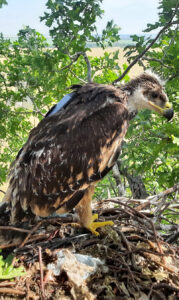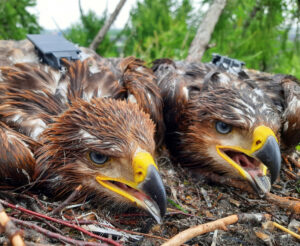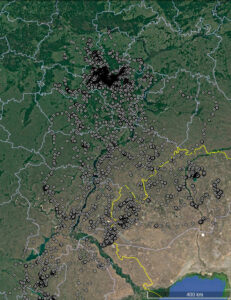Third International Scientific and Practical Conference “Eagles of the Palearctic: Study and Conservation”
Raptors Conservation. Suppl. 2. Proceedings of Conferences
On the Natal Philopatry of the Eastern Imperial Eagle of the Volga Population
Korepov M.V. (Ulyanovsk State Pedagogical University named after I.N. Ulyanov, the Sengileevsky Mountains National Park, Ulyanovsk, Russia)
Contact:
Mikhail Korepov korepov@list.ru
Recommended citation: Korepov M.V. On the Natal Philopatry of the Eastern Imperial Eagle of the Volga Population. – Raptors Conservation. 2023. S2: 305–307. DOI: 10.19074/1814-8654-2023-2- 305-307 URL: http://rrrcn.ru/en/archives/35104
Population structure across the range of the Eastern Imperial Eagle (Aquila heliaca) remains one of the controversial issues that can be resolved by data on the distribution of juveniles from different points in the range. However, the long period of puberty, the difficulty of establishing a new nesting site in conditions of limited food resources and nesting habitats, the high mortality of juveniles and the short lifespan of tracking devices make this task very difficult. In this respect, any reliable data on the natal philopatry of the Imperial Eagle is of great interest.
We have been tagging eagles in the Ulyanovsk Region since 2017. During this time, 30 juvenile Imperial Eagles were fitted with Aquila GPS/GSM trackers. During subsequent tracking of the tagged individuals, two nesting attempts were recorded.
The first nesting attempt was observed with the female eagle Avralka, which was tagged as a chick in 2017 in the Melekessky district. In the spring of 2021, Avralka stayed near the renovated nest until early May, but did not breed that season and the connection with the bird was lost after that. Avralka's nest was also located in the Melekessky district, only 12 km from her parents' nest. This nesting site was previously unknown to us.
In 2023, the male eagle Sura, tagged as a chick in 2018 in the steppe valley of the middle reaches of the Sura River in the Karsunsky district, began nesting. On 25 May 2023 we visited its permanent site this spring and found an occupied nest with a clutch of one egg. When we visited the nest again on 14 June, we did not find a hatchling, apparently it had died in the early stages of development due to malnutrition. Sura's nesting site is located in the Dubensky district of the Republic of Mordovia, 23 km from the nesting site of its parents.
Thus, in both cases, adult birds attempted to nest in the area where they were born, even though juveniles migrate quite widely during their first few years of life. This fact, despite the small sample size, suggests a rather strong natal philopatry, at least for some individuals of the Imperial Eagle, both males and females.
The research was conducted as part of the "Study and Conservation of the Eastern Imperial Eagle" project carried out by the Non-Governmental Nature Conservation Centre "KAVKAZ” (NABU-Kavkaz) in cooperation with the Russian Bird Conservation Union (RBCU) and the German Nature and Biodiversity Conservation Union (NABU), with support from the NABU International Foundation and the VGP Foundation.



